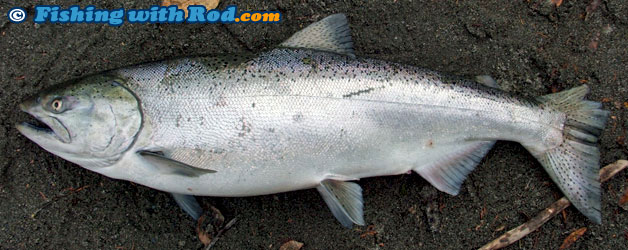Chinook Salmon
Oncorhynchus tshawytscha

Chinook salmon are more commonly known as a "kings" in USA or "springs" in Canada. Fish that weigh over 30lb are also known as "tyees". It is the largest species in the pacific salmon family. They are widely targeted by both freshwater and saltwater sportfishermen in British Columbia due to their size, robust strength and fine taste.
Description
There are several distinct characteristics that separate a chinook salmon from the other salmonid species. Chinook salmon's gum is black but the outer edge of their jaw is white, therefore they are also called blackmouths. Their blue-green back and tail are completely covered with tiny spots. Chinook salmon's head tends to be shorter than other salmon species. They are sometimes called "blunt-nose". The average size of chinook salmon is between 10lb and 20lb, while fish over 30lb are not rare. Rivers in Northern British Columbia commonly produce fish above 40lb.
Jack chinook salmon are males that return to their natal streams one year earlier than other adults. Jacks are categorized as either fish that are under 62cm or 50cm, depending on which natal stream the fish return to. Jacks tend to have larger spots than full-grown adults.
Distribution
Chinook salmon are native to Pacific Ocean and its coastal streams. In North America, they are found in streams from Alaska to as south as Ventura River, California. They are also found in the Bering Sea, Sea of Japan and parts of the Arctic region. They have been introduced into the Great Lakes to further expand angling opportunity since the 1960s.
Life History
Chinook salmon possess the typical anadromous life cycling of a pacific salmon. The length of their life span and migratory pattern vary between regions. Spawning adults return to their natal streams for spawning after feeding in the Pacific Ocean for several years. Eggs hatch once winter is over. On average, fry migrate into the ocean after rearing in streams for a length of time. The length of rearing time once again is regional-dependent, which can vary from three months to one year.
In the ocean, they may stay close to shore or make extensive migration across the Pacific Ocean. Youngs in streams feed on insects. This diet changes from crustaceans to herring and other baitfish once they become adults in the ocean. Eggs and juveniles in streams are preyed on by birds and other fish such as trout, char and minnows, while adults are preyed on by sharks, killer whales, seals, bears and human.
Fishing Locations
Chinook salmon are targeted in the ocean during the final few months of their ocean phase, when they stage and enter the river. Between May and September, saltwater anglers prefer to fish for chinook salmon on the West Coast of British Columbia, where they feed aggressively on baitfish such as herring and anchovy.
In larger rivers such as the Fraser and Skeena, they are targeted from boats in mid to late summer. Smaller tributaries also offer good chinook salmon fishing between August and October. In Southern British Columbia, Chilliwack, Harrison, Thompson, Stamp Rivers are popular chinook salmon fishing destinations.
Fishing Techniques
There are numerous techniques that can be used for chinook salmon and it depends on your fishing location. In the ocean, chinook salmon are taken by trolling baitfish, hootchies, spoons and plastic bait. Mooching and lure jigging are also two popular techniques employed by saltwater anglers. Timing and depth selection are important keys whenyou are attempting to find a school of chinook salmon.
In large rivers such as the Fraser River, they are taken by barfishing with a large spin n glow. The spin n glow is anchored by the large weight on the river bed and spun by the river current, causing fish to strike as they swim up to it
In smaller tributaries where chinook salmon return to spawn, they can be caught by lure casting or float fishing. Popular bait or presentations used under a float in rivers include roe, shrimp and wool in various colours. Big spoons and jigs are common lures used when lure casting for them. Fish are generally found in deep runs and pools, especially on bright days when they need to find structures for protection.
